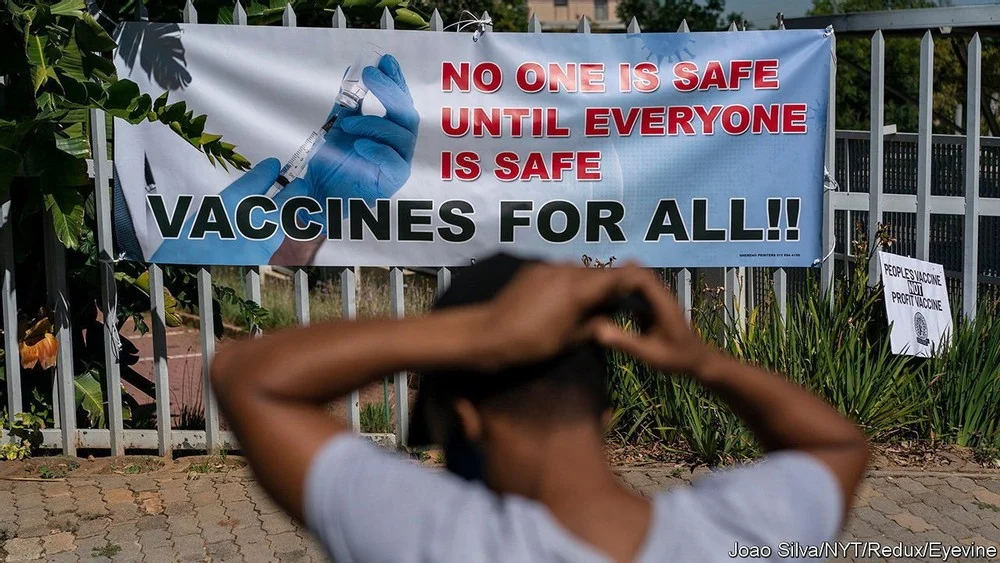That may mean stricter lockdowns lie ahead
VIRUSES reproduce abundantly, and with imperfect fidelity, so mutations are commonplace among them. Most such mutations, though, have little or no effect on how a virus spreads or how deadly it is. And, until recently, SARS-CoV-2, the covid-19 virus, has been no exception to that rule.
Regrettably, this seems to be changing. A new variant of the virus, known as B.1.1.7, is spreading rapidly through Britain, and local scientists estimate that it is about 50% more transmissible than other variants currently in circulation. The British authorities are therefore rushing into action to try to limit its spread. Those parts of the country where B.1.1.7 is most prevalent, including London, went into lockdown on December 20th. But cases have been turning up elsewhere, and more areas will be locked down from December 26th. More than 50 countries, moreover, have closed their borders to arrivals from Britain. Some parts of Europe are admitting only those who can show evidence of a recent negative test.
At the moment, only a few cases of B.1.1.7 are known from places other than Britain—though it has turned up Australia, Denmark, Iceland and the Netherlands. Many experts think, however, that it is already circulating more widely than that. It is likely Britain rang the alarm bell first because it has a well-organised system for sequencing the genes of viral samples taken from patients. About 10% of virus-positive samples are so sequenced, compared with either about 1%, or none at all, in most other European countries. According to Thomas Connor of Cardiff University, in the past week alone more samples have been sequenced in Wales (population 3m) than in France (67m) during the entire pandemic. Similarly, one estimate suggests that America has sequenced only about 40 samples since the beginning of December, compared with more than 3,700 in Britain.
It is not yet clear whether B.1.1.7 causes symptoms that are any more severe than those induced by its longer-established cousins. Studies to answer this question are under way, but encouragingly hospital-admission data in B.1.1.7 hotspots do not imply that the new variant is making people more ill.
Researchers in Britain are also looking for further evidence that B.1.1.7 is more contagious than previous strains—and, if so, why. The two factors which currently suggest its greater contagiousness are its speed of spread and the details of its mutations.
That B.1.1.7 has spread faster than older versions of SARS-CoV-2 in those parts of Britain where infections have been rising unusually rapidly seems certain. It accounted, for example, for 62% of new infections in London in the week ending December 9th, up from 28% in early November. It has also accumulated an exceptionally large number of mutations—23 of them, only six of which are silent (meaning they make no difference to the final composition of the proteins encoded by their parts of the virus’s genome).
Yet more worryingly, both laboratory and animal studies have found that some of the 17 non-silent mutations in the new variant make it better at infecting cells, at making more copies of itself once it enters those cells, and at evading antibodies originally generated by the immune system during infections with other variants.
Perhaps the best evidence that B.1.1.7 is more contagious, though, is that those infected by it have higher viral loads—that is, they have more virus particles in their throat and nose swabs—than people infected by other variants. The role of viral load in contagiousness was, until recently, based on supposition rather than evidence. But a new study in Britain of about 30,000 infected people and their close contacts shows that the likelihood of someone with SARS-CoV-2 infecting others increases steadily with viral load.
Reinforcing this point, researchers from South Africa, which also has an efficient covid-19 genome-sequencing programme, have found that a fast-spreading variant detected there also has an unusually high number of mutations and shares one in particular with B.1.1.7. The South African variant is also linked to higher viral load, and has been suggested by researchers as a reason why the epidemic there has accelerated. Several countries have also banned travellers from South Africa.
A big worry with the emergence of B.1.1.7 and similar variants is whether they may reduce the effectiveness of covid-19 vaccinations. Several of the changes in B.1.1.7 are in the gene that encodes “spike”, a protein found on the surfaces of coronavirus particles which they use to enter cells. Spike is the target of the first covid-19 vaccines. But these vaccines stimulate immune reactions to parts of the protein not affected by those mutations. There is a broad consensus among experts that vaccines already in use against SARS-CoV-2 will be effective against the B.1.1.7 variant, at least until large numbers of people are vaccinated. At that point, however, natural selection will begin to favour mutations which evade the vaccine’s effects.
In the meantime, a lurking fear is that far stricter measures than have been employed previously will be needed to slow the spread of covid-19 wherever B.1.1.7 lands. All eyes are on Britain, where results from the current lockdown in London and other hotspots will provide, over the next couple of weeks, a rough idea of how much such lockdowns can achieve. If these measures fail to bend the epidemic curve downward, hospitals everywhere may have to brace themselves for yet another wave of covid-19 patients.
By The Economist





